Programme 2022
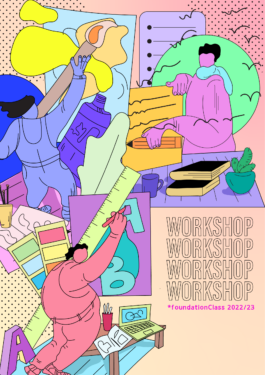
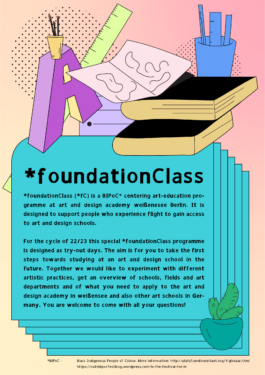
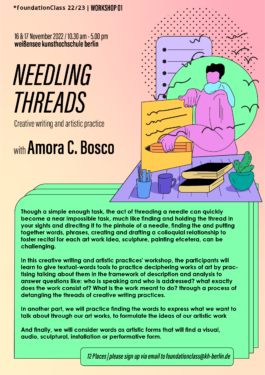

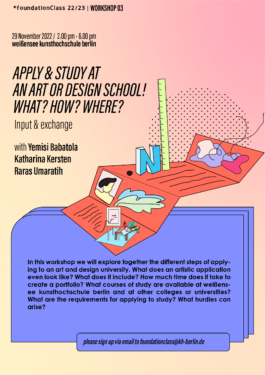

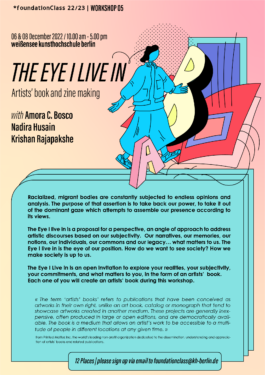
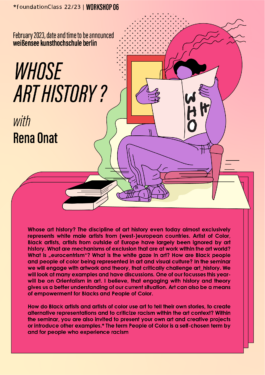
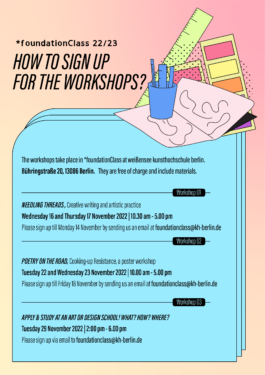
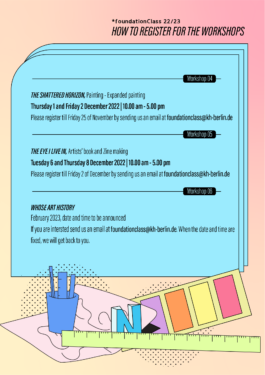

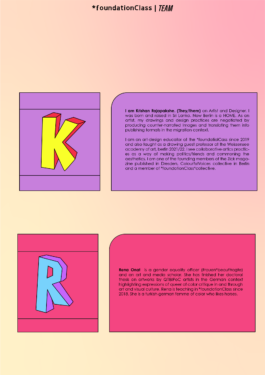
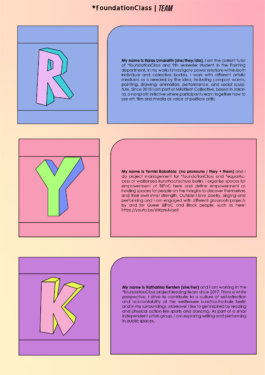
2021 Programme and Community Agreement
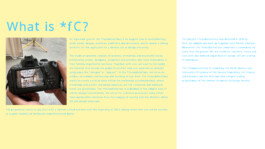
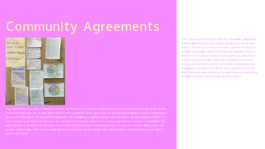
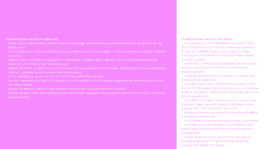

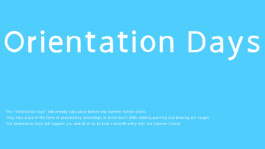
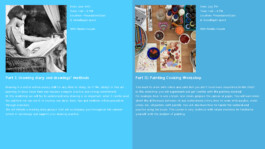
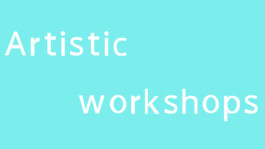
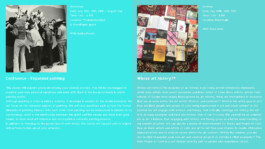
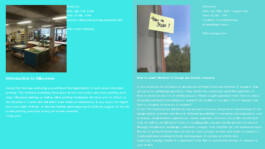
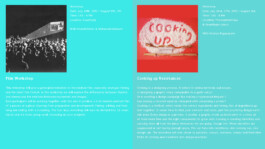
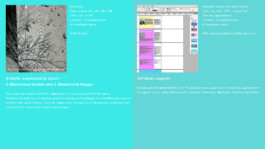
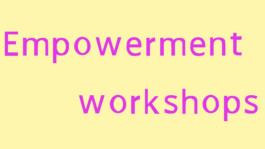
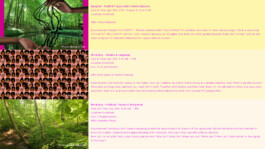
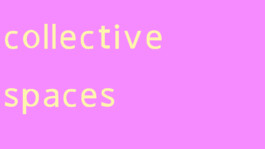
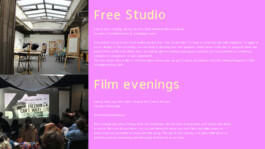
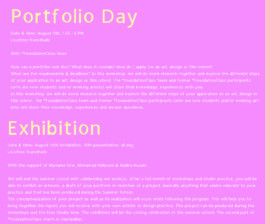
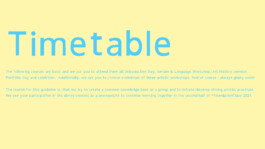
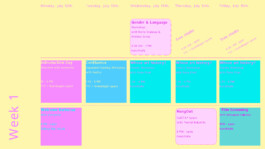
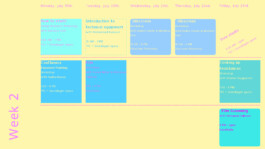
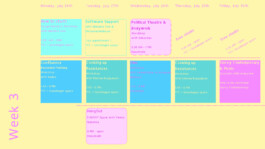
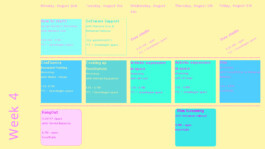
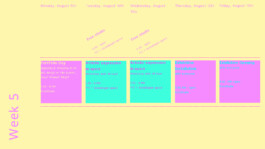

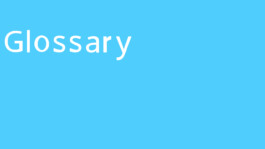
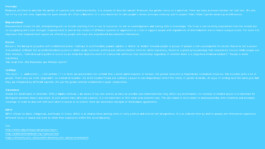
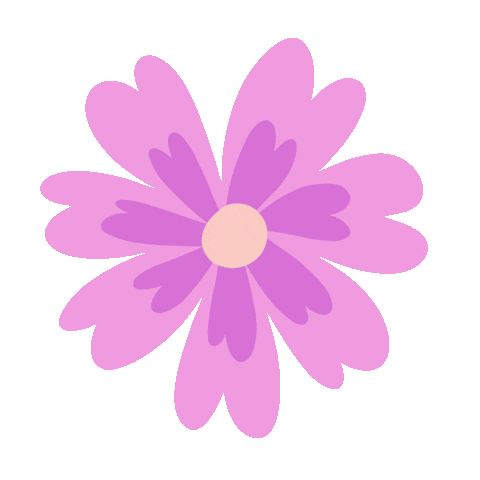
Programme 2020
The programme will be divided into two parts: The first part of the program will feature lectures, workshops and excursions led mainly by professional artists, scholars, and activists who themselves or whose families have migrated to Germany.
During the first part, you will have the possibility to arrive at the school, get to know many other people and experiment and get to know different mediums and practices. Together we want to formulate art historie(s), that include the Global South/East, as well as your experiences without using labels such as ‚Refugee‘ or ‚migrants‘
Together we want to find answers to the question of how the art schools of the future would look if they really recognized migration as an essential societal factor?
The first part of the programme (summer semester) will also be open to other students studying at weissensee academy of art.
In the second half of the program (winter semester), we want to take all that we have learned and prepare applications for German art and design academies. In different workshops (painting, sculpting, digital media, design, drawing etc.) we will support you in creating a powerful portfolio with which you can apply.
To realise these goals weissensee art academy provides its entire infrastructure, including workshops, materials, as well as support with bureaucratic problems.
The *foundationClass strives to open up a social space within weissensee academy of art within which knowledge and artistic and design practices are not consumed, but questioned and where new forms of knowledge and practice will be produced collectively.
Duration and expected time requirements
The *foundationClass group will work together from May until the beginning of the next year. The *foundationClass is a rather intense and time consuming program. Classes take place most of the days during the afternoons so you will have time to attend your German courses during the morning.
Who should apply?
Anyone who has come to Germany and has applied for asylum (please note that the outcome of the application, or whether the process is finished or still ongoing is not relevant) and is interested in art and/or design, is 18 years or older, is ready and motivated to participate regularly in the program (please note that participation in the second part of the program will depend on regular attendance of the first part) and anyone who has working knowledge of English and/or German (please note that for an application at an art academy sufficient German skills are mandatory!)
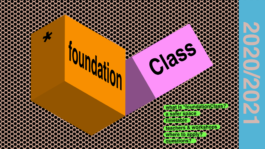
Archive programme 2017-19
Programme 2019
1. Nadira Husain
DAS MEDIUM ZEICHNEN
Wir können aus vielen Gründen mit dem Medium Zeichnen arbeiten: Um eine künstlerische Arbeit herzustellen. Aber auch um Ideen, die wir haben in eine visuelle Form zu übersetzen, zum Beispiel story boards, erste Skizzen für eine Skulptur, eine Installation, oder einen Designentwurf. In diesem Workshop experimentieren wir mit verschiedenen Techniken und Methoden des Zeichnens.
Montag - Dienstag: Einführung in die verschiedenen Techniken, Mittwoch: „Ich skizziere mein eigenes Projekt“, Donnerstag - Freitag: Von der Zeichnung zum Druck.
EXPLORATION OF THE MEDIUM DRAWING
We can use drawing for many purposes: to do an art work but as well to translate some of our ideas into a visual form, examples: story boards, sketches for a sculpture, an installation, a design etc. During the workshop we will try several drawing technics and methods.
Monday-Tuesday: General drawing practice introduction, Wednesday: "I sketch my project", Thursday -Friday: From drawing to silk screen print.
2. Rena Onat
PEOPLE OF COLOR*PERSPEKTIVEN UND SCHWARZE PERSPEKTIVEN IN DER KUNST(GESCHICHTE)
Welche Künstler_innen of Color und Schwarze Künstler_innen hat es gegeben? Wie nutzen sie ihre Kunst um eigene Geschichten zu erzählen, um andere Bilder zu entwerfen und für Kritik an Rassismus in der Kunst?
In der Kunstgeschichte kommt fast nur die Kunst von weißen Männern aus westeuropäischen Ländern vor. Bis heute hat die Kunstgeschichte die Kunst von Künstler_innen of Color, Schwarzen Künstler_innen und außereuropäischen Künstler_innen größtenteils ignoriert. Wodurch entstehen in der Kunst Ausschlüsse von People of Color und Schwarzen Menschen? Wir werden uns im Seminar mit Kunst und mit Texten beschäftigen, die erklären, wo in der Kunst überall Probleme mit Rassismus bestehen. Was ist „Eurozentrismus“? Was ist der weißeBlick in der Kunst? Wie werden Menschen of Color und Schwarze Menschen in Kunst und in Bildern allgemein repräsentiert? Der Begriff der "Repräsentation" (Stuart Hall), hilft zu verstehen, was Bilder mit Rassismus zu tun haben. Wie lassen sich rassistische und andere Stereotype verändern? Wir werden sehr viele Beispiele ansehen und diskutieren. Wir werden Kunst aus der Perspektive von People of Color und Schwarzen Menschen kennenlernen, die uns hilft, Kritik an Rassismus in der Kunst und in der Kunstgeschichte zu verstehen. Kunst kann für Schwarze Menschen und People of Color auch Empowerment sein. Ihr könnt im Seminar auch gerne eure eigenen Arbeiten zeigen oder inspirierende Arbeiten von anderen vorstellen.
* Der Begriff People of Color ist eine Selbstbezeichnung von Menschen, die Rassismus erfahren
BLACK AND PEOPLE OF COLOR*PERSPECTIVES IN ART(HISTORY)
Which Black artists and artists of color are known in art history? How do Black artists and artists of color use art to tell their own stories, to create alternative representations and to criticize racism within the art context?
The discipline of art history even today almost exclusively represents white male artists from (west-)european countries. Artist of Color, Black artists and non-european artists have largely been ignored by art history. What are mechanisms of exclusion that are at work within the art world? In the seminar we will engage with art and theory that highlight problems with racism within the context of art. What is „eurocentrism“? What is the white gaze in art? How are Black people and people of color being represented in art and visual culture? The term „representation“ (Stuart Hall) helps to understand how visual images and racism are linked. How can racist and other stereotypes be deconstructed and changed?
We will look at many examples and have discussions. We will look at art from Black artists and artists of color that helps us to understand criticism of racism in art and art history. Art can also be a means of empowerment for Blacks and People of Color. Within the seminar, you are also invited to present your own art work or introduce other examples.
* The term People of Color is a self-chosen term by and for people who experience racism
3. Can Mileva Rastovic
ZUR FOTOGRAFIE - EINFÜHRUNG
In diesem Workshop werden wir, mit Blick auf eure eigene fotografische Praxis als Autorin und Autor, mit grundlegenden Techniken und Genres der zeitgenössischen Fotografie experimentieren, wie z.B. Porträt, “Dokumentarfotografie” und die Inszenierung von Objekt und Raum.
Aber auch die Fotografie als Recherchemethode für deine künstlerische Arbeit schauen wir uns an, sowie die fotografische Dokumentation mancher deiner Arbeiten für dein individuelles Portfolio. Dazu gehen wir z.B. auch in die Fotowerkstatt der Hochschule. An einem Kick-off Wochenende fangen wir an und erforschen fotografische Strategien in der Gruppe. Danach arbeiten wir one-on-one in Einzelterminen weiter.
ON PHOTOGRAPHY - INTRODUCTION
In this workshop we will have a look at your practice of photography and/or dive into developing your own individual practice. This will happen through experimenting with different techniques and genres of contemporary photography like portraiture, “documentary” and staged photography, for example.
Photography is also an essential practice to develop your research on other medias you might like to use. Finally it will come to life in documenting many of your works, representatively, for your individual portfolio. We will start at a kick-off weekend and explore together strategies in photography. We will work in the schools studios und will then continue one-on-one to develop your individual practice.
4. Ali Kaaf
KÜNSTLERISCHER AUSDRUCK IM RAUM
3-dimensionale Modelle und 2-dimensionale Abbildungen - Der Workshop vermittelt Herangehensweisen, um Ideen im Raum visuell auszudrücken. Die Studierenden lernen, wie man künstlerische Prozesse und Strategien dazu entwickelt. Sie setzen ihre Ideenskizze in einem dreidimensionalen Raum-Modell um. Anschließend wird das Resultat in zweidimensionale Abbildungen übersetzt.
ARTISTIC EXPRESSION IN SPACE
3-dimensional models and 2-dimensional images. The workshop teaches different approaches to visually express ideas in space. The students learn how to develope artistic processes and strategies. They implement their concept in a 3-dimensional model. In the next step they translate their result into 2-dimensional images.
5. Elena Aguidio / Markus Aviv
TO ORGANIZE DELIRIUM - MANIFESTOS AND ARTISTS’ WRITINGS
Der Workshop To Organize Delirium stellt internationale Kunstströmungen des 20. Und 21. Jahrhundert vor. Am Beispiel von Künstlermanifesten und Texten besprechen und diskutieren wir den geschichtlichen Zusammenhang in dem sie stehen. Wir üben gemeinsam das Material vorzustellen und davon ausgehend Ideen zu skizzieren, die für die eigene künstlerische Praxis genutzt werden können.
In the workshop To Organize Delirium w e focus on international art practices from the 20th and 21st century through artists’ writing and manifestos. We are going to read the manifestos together, and to analyse them and discuss about the historical context from which they emerged. We will give exercises and time to share opinions on the material presented, and to sketch or draw ideas for individual artworks.
6. Fadi Bitar
Produktionsdesign
WHAT IS DESIGN THINKING WORKSHOPS FOR? WHY STUDYING DESIGN THINKING?
Um Design zu studieren muss man nicht Designer*in werden. Das Designstudium ist auch eine sehr gute Grundlage um Künstler*in, Architekt*in, Lehrer*in, Musiker*in oder Autor*in ect. zu werden. Die Design Ausbildung ist Zugang zu vielen Bereichen der digitalen Kultur wie dem Internet, der Kommunikationstechnologie, Architektur, Theater, Film und Fernsehen, Industrie- und Produkt Design, Werbung, Marketing oder im Allgemeinen der Entwicklung eines eigenen Unternehmens oder start-up. In diesem Workshop erforschen wir dazu die Methode DESIGN THINKING um uns inhaltlich und strategisch den verschiedenen Bereichen von Design zu nähern.
In this workshop we will explore the method of design thinking:
“You don’t have to become a designer to study design. Maybe you’re thinking about
becoming an artist, an engineer, an architect, a teacher, a musician, a writer...
Studying Design as a subject provides you with life-long skills irrespective of whether or not you embark on a career in Design. Design education is relevant to those interested in diverse fields, including Internet and Communication Technologies, Architecture, Industrial Design, Advertising, Marketing, Business Development and Entrepreneurship, Fashion, Visual Merchandising, Interior Design, Theatre, TV Production, Film, Publishing, Animation, Multi Media, service design and interaction design. Choosing design as a subject can teach you very valuable skills that will prepare you for the world and a wide variety of careers in the future. In other words, design can help to develop skills that can help you to navigate a very complex world.
Many popular professions of today were completely unheard of 10 years ago. Just imagine what the career landscape would look like in 10 years time? We believe that there are going to be many more professions that we cannot even imagine today. Within the context of such an uncertain future, it is vital that the new generation is equipped with skills that can empower them to manage complex & unfamiliar situations / conditions with more ease & confidence.” (Source: Suné Stassen, Creative Director: Rock City Foundation)
Muhammed Jabali
ZEITGENÖSSISCHE KUNST IM MITTLEREN OSTEN
In diesem Workshop wollen wir eine temporären “Öffnung” zur gemeinsamen Forschung schaffen. Wir unternehmen den Versuch uns als Gruppe von Vortragenden und Studierenden, mit ganz unterschiedlichem Wissen, einer Frage aus verschiedenen Richtungen zu nähern:
Was ist Zeitgenössische Kunst? Kann das zeitgenössische Moment vom westlichen Moment denn getrennt werden? Oder ist das zeitgenössische Moment doch universell? Was gehört demnach zur Geschichte der zeitgenössischen Kunst?
Während einer intensiven Woche, untersuchen wir gemeinsam, diese nach wie vor brandaktuellen Fragen zu der Beziehung von zeitgenössischen Künstler*innen aus dem “Globalen Süden” zur dominierenden zeitgenössischen Kunstszene der westlichen Welt. Der Fokus wird besonders auf Künstler*innen des arabischen Raumes, wie dem Libanon, Palästina, Ägypten und Syrien liegen. Weitere Themen werden sein:
Das Spannungsfeld Dokument und künstlerische Arbeit - Was ist der Unterschied?
Bedarf es eines Dokumentes um ein Trauma überhaupt wahrzunehmen? Benötigt auch eine Erzählung ein Dokument um vermittelt zu werden?
Das Arabische im 20. Jhd - Wie sieht es auch? Und wer betrachtet es?
Wer erschafft die Kunstwelt? Künstler*innen oder die Betrachter? Welche Sprache spricht deine Kunst? Zu wem spricht sie?
CONTEMPORARY ART IN THE MIDDLE EAST
The workshop aims to create a temporal spatial window to examine, discuss and develop the understanding we have as a sharing knowledge group of lecturers and students toward the question of: W hat is a Contemporary Art? Can the contemporary moment be separated from the Western Moment? Is the contemporary moment universal? What is the history of the contemporary art work?
During an intensive week, we will examine together questions that are still burning in the relationships of Artists from the “Global South” with the predominantly western Contemporary Art Scene. While focusing on examples and practices of Artists from the Arab World, specially in the Eastern Mediterranean.
Through the works of several influential artists from Lebanon, Palestine, Egypt, Syria and other countries the workshop will examine theoretical questions frequently faced by Artists from the region today and in past several decades.
Thematically the workshop will attempt to provide students with tools for strengthening their ability to forge ideas around these main themes:
*- The tension between the Document and The Work Of Art. Is there a difference between a document and an Art Work?
Do we need an archive to create shared memory?
Does a trauma need a document to be recognized? Does a story need a document to be told?
*- The image of the Arab in the 20th century. What does an Arab look like? Who is looking?
*- Who creates the art work? the artist or the viewer? What language does your art speak? Whom are you talking to?
8. Sandy (Paul Omar Abdullah Alexander) Kaltenborn
VISUELLE KOMMUNIKATION
Ich sage „Baum!“ und du denkst „Eiche!“. Aber ich meinte Palme.
Ich sage „Stadt!“ und du denkst „Häuser!“ Aber ich meinte Menschen.
„subtitles/captions and the city“
Ein praktischer und spielerischer Workshop zu Text / Bildverhältnis. Wir werden Foto & grafisch mit „Bildunterschriften“ / „Untertiteln“ arbeiten! Wir streifen durch die Stadt - fotografieren bekannte und unbekannte Orte, private und öffentliche Gebäude und Situationen. Wir versehen diese mit (unseren)Text-Kommentar/en. Mal banal, mal provokativ, poetisch und subversiv, formal und subjektiv. Wir stellen damit neue illustrative, narrative, erörternde, kommentierende Lesarten der Bilder, Orte und Situationen her. Wir schulen unseren Blick, wir unterlaufen das Gewohnte und bieten mit unserer Gestaltung den Rezipient*innen an, die eingespielten Wege mit uns zu verlassen.
In diesem Workshop werden wir als Gruppe arbeiten. Zusätzlich wird jede*r eine eigene Arbeit produzieren. Neben der Projektarbeit soll es sowohl Raum zum Austausch zu allgemeinen Fragen der Visuellen Kommunikation / Grafik Design geben, als auch Feedback für Eure Mappenerstellung.
Jeder Workshoptag besteht aus 2 Teilen: 1. Inhaltliche Diskussion / 2. praktische Arbeit
VISUAL COMMUNICATION
„subtitles/captions and the city“I say "tree!" and you think "oak tree!“. But I meant palm tree.
I say "city!" and you think "houses!" But I meant people.
A practical and playful workshop on text / image ratio. We will work photographically (& graphic tools) with "captions" / "subtitles"! We roam the streets of the city - photographing known and unknown places, private and public buildings and situations. We provide them with (our) text comment(s). Sometimes banal, sometimes provocative, poetic and subversive, formal and subjective. In this way, we create new illustrative, narrative, discussing, commenting readings of the images, places and situations. We train our gaze, we ́ll undermine the familiar and with our design we offer the recipient to leave the well-rehearsed paths with us.
In this workshop we will work as a group. In addition, each of us will produce our own work. And also addition to the project work, there will be space for exchange on general questions of visual communication / graphic design, as well as feedback for your portfolio creation.
Each workshop day consists of 2 parts: 1. content discussion / 2. practical work
9. Didem Pekün
FILM UND VIDEO
“Dieser 5-Tage Workshop führt alle Teilnehmenden in die myriadischen Wege ein, wie wir über Film und Video als Bewegtbild denken und kommunizieren können.
Der Kurs vermittelt Prinzipien einer Grammatik des Filmemachens, nach kurzen Vorträgen werden wir so an die Formulierung von Sätzen herangehen. Während der ersten Tageshälfte schauen wir uns jeweils verschiedene Film Genres wie Fiction, die Avantgarde der filmischen Moderne und den Dokumentarfilm an. Am späten Nachmittag produzieren wir dann dazu in der Gruppe eigene mini Videos.”
FILM AND VIDEO
"This 5 days workshop introduces the participants to the myriad ways with which one can think and communicate with moving images. To that end the course introduces the participants to the principles of the grammar of filmmaking, and then we will attempt to make sentences based on the lectures. While the first half of our days will be based on Didem’s presentations where we will cover different filmic modes – from fiction to the modernist avant-garde to documentary – the late afternoons will be devoted to making mini videos in groups & always together."
10. Nadira Husain
MALEREI UND ERWEITERTE MALEREI
Die Erforschung des Mediums Malerei aus einem zeitgenössischen Blickwinkel: Die Zeitgenössische Befragung zur Malerei, das Medium der Malerei selbst und die traditionellen Formen, nenne ich erweiterte Malerei.
Du wirst das Medium erforschen und dadurch deine eigene Praxis der Malerei entwickeln. Ich stelle verschiedene Beispiele der zeitgenössischen Malerei vor. Wir lernen wie diese Werke gelesen werden können, hängen regelmäßig deine Arbeiten und diskutieren sie gemeinsam.
PAINTING AND EXPANDED PAINTING
Exploration of the painting medium in a contemporary understanding of it.
Contemporary painting questions the medium itself and its traditional forms: this is what I am calling expanding painting.
You will be able to discover the medium and to develop your own painting practice.
I will show you different examples of contemporary paintings. We will learn how to read those works and will regularly hang your works and discuss them.
11. Marina Naprushkina
RUNDGANG WEIßENSEE
In diesem Workshop gehen wir der Frage nach:
Was und wie möchte ich heute lernen / Was heißt für mich lernen und was erwarte ich von einer Kunsthochschule heute?
Wir arbeiten mit einfachen Materialien und verschiedenen Medien: Zeichnung, Druck, Fotografie und Video. Es wird sowohl einzeln als auch in Gruppen gearbeitet. Als Ergebniss soll eine Rauminstallation entstehen, die beim Rundgang der kunsthochschule weißensee berlin gezeigt wird
In this workshop we will focus on the question: What and how to learn today?
What does learning mean to me individually? And what are my expectations regarding this towards an arts academy?
To explore this, we will work with basic materials and diverse materials: Drawing, printing, photography and video. We will work individually and in the group. As a result we will develop an installation in the whole space which will be shown at the traditional “Rundgang” in Weißensee.
Programme 2018
Monday
In the Monday class on "Art histories and theory / Annotating art's histories" we reflect together on the implicit colonial and imperialist assumptions present in Western academic disciplines of art history and theory. Focusing on an attentive analysis of the Western art canon, we delve into key figures and historical fundamental moments, from the late Middle Age/early Reinassance, when the figure of the artist as author and intellectual is born, to Modernism, to Contemporary art, until the current discourse.
Tuesday
You don’t have to want to become a designer to study design. Maybe you’re thinking about becoming an artist, an engineer, an architect, a teacher, a musician, a writer… Studying Design as a subject provides you with life-long skills irrespective of whether or not you embark on a career in Design. Design education is relevant to those interested in diverse fields, including Internet and Communication Technologies, Architecture, Industrial Design, Advertising, Brand Development, Marketing, Business Development and Entrepreneurship, Fashion, Textiles, Visual Merchandising, Interior Design, Theatre, TV Production, Film, Publishing, Animation and Multi-media, service design and interaction design. Choosing design as a subject can teach you very valuable skills that will prepare you for the world and a wide variety of careers in the future. In other words, design can help to develop skills that can help you to navigate a very complex world. Many popular professions of today were completely unheard of 10 years ago. Just imagine what the career landscape would look like in 10 years time. We believe that there are going to be many more professions that we cannot even imagine today. Within the context of such an uncertain future, it is vital that the new generation is equipped with skills that can empower them to manage complex & unfamiliar situations / conditions with more ease & confidence. We believe that design & creative activities can be the vehicle to develop such skills that can help the future generation to manage an uncertain future.
Source: Suné Stassen, Creative Director: Rock City Foundation
Design class objectives and methods:
- Implant the basic knowledge seeds wich through time and practice will grow to become your tools and ammunition to survive and thrive in any creative environment by introducing a weekly 50 minutes Design Skills seminars.
- Make “design thinking” method a normal, easy and built-in skill within your skills which will improve your self confident in your design capabilities and your creativity by applying 50 minutes “design thinking” workshops once a week.
- Illuminate the path for your prosper future by widening your perception regarding the design and creative topics by discussing the results of the weekly workshops for 50 minutes per week.
- Motivate and guide you to produce new creative professional materials for your portfolio by customizing a weekly 50 minutes for one project of your choice
Fadi Bitar
Wednesday
Time, Place and Light are the guiding notions for this course. Three core elements for any form of film, video and photo making. From step 0 to step 100, throughout the course participants will go through the production of a new project. A self-portrait, a music video, and a short film are the outcomes of this process. Azin Feizabadi
Thursday
The Thursday class focuses on Pictorial questions. Concrete media such as painting, drawing or printing will be practiced as well as be expanded into the space and interactions with other media. The class functions as a studio where participants are concretely working on their artworks. The class has a horizontal structure where the participants provide for the contents of the class through weekly presentations. We are learning how to develop our art practice and we are searching for accurate relations between the concept/content of the artwork and its formal realization. We are also, through the exercise of looking and discussing diverse artworks, artist practices or exhibitions enriching our experience of looking. Nadira Husain
Friday
in collaboration with all the workshops:
The seminar ‘Politics of Form – An Introduction to Contemporary Art Practices’ aims to focus on fairly recent art practices. We will exercise our skills in viewing and describing art using artworks by Hito Steyerl, Barbara Kruger, Arthur Jafa, Felix Gonzalez-Torres, Hilma af Klint, and others. The focus lies in how each individual student approaches an artwork rather than through art historical contextualization. For each meeting, three to five students will prepare to introduce the artwork to the larger group. The boundaries of what is or could be a form of art production shifted drastically in the second half of the 20th century, and these new forms of art production cannot be easily conveyed through a single photograph. Therefore, the students’ descriptions will be a way to try to understand the formal and material complexity of the artworks under discussion. Markues Aviv
16.07.-01.09.
Summer break
01.09.-01.02.2019
the second part of the program/preparation of the application portfolios
Programme 2017
Ali Kaaf: BLACK BOX
Performative workshop dealing with different materials, projections, video installations and photography. The aim is to collectively shape a dark room – the BLACK BOX
Ali Kaaf is a free-lance artist and lives and works in Berlin www.alikaaf.net
Keren Manor: Introduction to Documentary Photography
In the era of digital photography, smart phones and social media, journalism and documentation become a more accessible tool for civil society. In the workshop we'll go through basic elements of photography, and discuss ethical and practical aspects in documentation, as well as representation and narration through photography. The workshop will try to place documentary photography as a tool for social change.
Keren Manor is a political activists, photographer, videographer and video editor. In 2005 she has been a founding member of the activist photographers collective Activestills. Together with the collective, she developed a variety of alternative ways to reach the public, such as street exhibitions, public events, independent publications and more. In 2006 she was a founding member of the Activevision group, and has been doing participatory documentary photography projects which wish to use stills and video photography as a way for social change through involvements.
Ali Mahmoud: Introduction to Design Thinking and Visual Language
The design process involves researching, inventing, and expressing ideas. It is a mix of intuitive and deliberate actions. The workshop introduces techniques for releasing creative energy and stimulating fresh thinking to arrive at compelling and viable design solutions.
Ali Mahmoud has over 25 years of experience in design and strategic branding in the Middle East and Europe. Worked as Creative Director in leading Branding Agencies in Frankfurt and Munich before launching Keybrand in 2005 with two offices in Frankfurt and Damascus. Studied Visual Communication in both Syria (Damascus University) and Germany (HfG Offenbach), and holds a Master's degree in Retail Branding from (ELISAVA, Barcelona).
A Parede: Impossible Methods - Design and the Myth of Objectivity
Design shapes the world around us, and enables types of interaction that determine how human and non-human beings navigate society. Design is key to determine how we perceive nature, culture, society, and each other. From graphic pieces – advertisement to memes – that construct a visual culture, to products that take a specific kind of body as default; or from urban designs made to be hostile to certain bodies and the modes of production embedded in every single gadget we use. Yet only certain practices are validated as being worth of the name "design." No wonder it became a trendy word that works as a placeholder for a taste regime rooted in whiteness, heterosexuality, and class privilege. This determines what is allowed to be ‘good’ design, and who is allowed to practice it – in detriment of what and who gets excluded. These assumptions almost always come embedded within a given design briefing, that is, what is understood that design can do, how it does it, and more importantly, for whom.
Our workshop aims to work with design at its most basic level: the briefing. In it we will find and unpack the political, cultural, and social facets of design, examining how designing as a practice sustains values that work, most of the time, against the fundamental differences in human interactions, and their interactions with artefacts in any given social and cultural context. Thus we will, together with the students, identify and interrogate where, in a common design practice, assumptions of a supposed "universality" of designed things gets normalized and perpetuated. These issues will be approached through quick exercises and debates where each student will be encouraged to speak from their specific position, and to articulate what they understand about the role of design in society. In other words, rather than teaching the students how to design, we will think together in order to identify where one might develop their design practice from, taking into account one's own backgrounds, histories, and expectations.
Luiza Prado de O. Martins and Pedro J S Vieira de Oliveira usually work together as A Parede; their work takes pride on the angry latin american trope, inviting for a decolonisation of design research via engagements with radical pedagogies, gender and sound studies. They are also 2/8ths of the Decolonising Design group.
Shanti Suki Osman & Miriam Schickler: Introduction to Sonic Arts
“We are looking for words; perhaps we are also looking for ears.”
Friedrich Nietzsche
This workshop will provide you with some theoretical, historical as well as practical input on the broad field of the sonic arts.
Together we want to explore the difference between the involuntary nature of hearing and the voluntary, selective nature - exclusive and inclusive - of listening. After we opened our ears we will go on a sound walk and discover the so called African Quarter of Wedding through our ears. We will record the sounds that we discover and later learn how to cut, paste, combine and process them.
Shanti Suki Osman (UK) is a Berlin based musician, radio maker, researcher and educator.
Miriam Schickler is a Berlin based anthropologist, activist, and sound artist.
Cana Bilir-Meier: The Archive within Artistic Practice. About Remembering within the Context of Migration
Based on artistic works and theoretical texts that deal with the archive in the context of migration, this workshop will introduce you to discourses of representation and visibility, as well as of constructions of memory and history and will analyse and discuss them. During the workshop we aim at having a group exchange about the participants' own artistic and theoretical practices. I therefore ask you to please bring your own artistic works, or works that have inspired you, which we will then put into relation with the themes discussed in this workshop. You can bring the works themselves, or on a USB stick.
Cana Bilir-Meier lives and works in Vienna. She studied art pedagogy and fine arts and works as a filmmaker, curator and educator. http://www.canabilirmeier.com
Nadira Husain - Narrative Structures, Sequential Pictorials, Comics in Painting
Through the observation of certain narrative modes of representation we will introduce notions such as time and space fragmentation in painting as well as the possibility of generating empowering subjects.
Nadira Husain'experiments with painting intend to question how cultural and economical globalisation conditions our relation to images. Her approach intermingle 'western' and 'eastern' concepts and understandings of archetypal imagery and intend to break with hierarchies of the 'western' anthropocentric value system.
Verena Melgarejo Weinandt: Photographic Bridges to Gloria Anzaldúa
In this photography workshop we will dedicate ourselves to the knowledge of Gloria Anzaldúa. Gloria Anzaldúa(1942-2004) referred to herself as Chicana, Texan from the working class, dyke-feminist poet, author-theoretician. She put into words what it means to inhabit a border. By border she does not only refer to a physical border, but those border(s) that those people inhabit and invigorate who for example have different cultural backgrounds, or speak multiple languages, or whose sexual orientation or gender identity diverges from the norm. She shows how subversive practices and forms of knowledge originate from within the border. In this workshop we will approach her theory through her own artistic practice. Photography will be used as a medium to look for bridges between Gloria Anzaldúa's theory and our own realities and identities. We will use analogue cameras which will be provided for the duration of the workshop. No prior knowledge necessary.
Verena Melgarejo Weinandt, German Bolivian artist, curator and researcher. She grew up in Berlin and moved to Vienna for a photography education at the Graphische. During her studies of fine arts and cultural studies at the Academy of Fine Arts Vienna, she worked as a freelance photographer and photography assistant. In 2014 she spent a year at the Instituto Universitario de Bellas Artes Buenos Aires. Her artistic works, located mainly in the realm of photography and performance were exhibited at the der friday exit gallery Vienna, nGbK Berlin and the Museo de Arte Contemporaneo Salta/Argentina. In 2016 she curated exhibitions at the Mueseum of Ethnology, Vienna and the Public Library of Vienna and was a fellow of kültürgemma!. Since 2017 she is a doctoral candidate with Dr. Ruth Sonderegger. She forms part of the collective TRENZA and the association Großes Schiff, where she has been organising artistic workshops and projects within and with the Latina Community.
Alok Vaid-Menon – Political Performance Intensive
Participants of all artistic disciplines are invited to join for an intimate and intensive creative workshop facilitated by trans performance artist Alok Vaid-Menon. Over three sessions Alok will guide participants through queer, decolonial, and transfeminist performance pedagogy to imagine and create art that ambitions beyond the status quo. With an emphasis on trauma, sexuality, legacy, embodiment, and gender we will work together to create political art to challenge institutions and ideologies.
ALOK VAID-MENON (they/them) is a performance artist, writer, educator, and entertainer. For the past decade Alok has worked with feminist, queer, and transmovements across the world. Their eclectic sense of style, political humor, and poetic challenge to the gender binary have been internationally renowned. Alok’s work has been featured by HBO, MTV, National Geographic, The Guardian, The New Yorker, and more.
Rajkamal Kahlon – Cutting Up the Frame
Working with common, everyday household materials, the drawing and painting workshop will examine the use of narrative, life-size portraiture, and collage aesthetics to address the politics of representation. We will consider the ways in which European identity depends on it’s invention of the “barbaric Other” and how aesthetic tools such as drawing, painting and collage might serve as potential anti-colonial processes.
In the work of American artist, Rajkamal Kahlon, we witness an autopsy, a dissection of the visual legacies of empire. The body -injured and transformed -is a reoccurring motif throughout Kahlon’s work. Her interdisciplinary practice questions the formal and conceptual limits of painting, photography and sculpture. Drawing on history, archives and literature, her research undergoes a process of creative transformation resulting in sensual, formally rigorous work.
Marina Naprushkina – Art as a Tool in Politics and in Everyday Life
What can art do other than hanging on the wall? Can art shape society? In this workshop we want to find out to which sociopolitical processes every one of us is consciously or subconsciously exposed and how our everyday life is being influenced by that. Can art influence processes or at least our relationship to those processes? We weill look at artistic works at the intersection of art/activism/the social. We will work with different media: drawing, video, photography, Object.
Marina Naprushkina is an artist, activist and author.
Founder of the Office for Anti-Propaganda The initiator of: Neue Nachbarschaft //Moabit (New Neighborhood//Moabit): the neighborhood initiative to support refugees. Started as a single initiative „Neue Nachbarschaft“ grew up to an one of the largest initiative in Berlin supporting refugees. Refugees‘ Library: Refugees‘ Library is an archive on courtroom sketches dedicated to asylum and migration politics. Беларусь//Институт Будущего (Belarus//The Institute of the Future): educational platform dedicated to politic, art and feminism, held by artists and activists in Minsk, Belarus.
Khaled Abdulwahed - Video and Film production
*foundationClass public program 2017 //fill in the blank see here
Programme 2022













2021 Programme and Community Agreement


























Programme 2020
The programme will be divided into two parts: The first part of the program will feature lectures, workshops and excursions led mainly by professional artists, scholars, and activists who themselves or whose families have migrated to Germany.
During the first part, you will have the possibility to arrive at the school, get to know many other people and experiment and get to know different mediums and practices. Together we want to formulate art historie(s), that include the Global South/East, as well as your experiences without using labels such as ‚Refugee‘ or ‚migrants‘
Together we want to find answers to the question of how the art schools of the future would look if they really recognized migration as an essential societal factor?
The first part of the programme (summer semester) will also be open to other students studying at weissensee academy of art.
In the second half of the program (winter semester), we want to take all that we have learned and prepare applications for German art and design academies. In different workshops (painting, sculpting, digital media, design, drawing etc.) we will support you in creating a powerful portfolio with which you can apply.
To realise these goals weissensee art academy provides its entire infrastructure, including workshops, materials, as well as support with bureaucratic problems.
The *foundationClass strives to open up a social space within weissensee academy of art within which knowledge and artistic and design practices are not consumed, but questioned and where new forms of knowledge and practice will be produced collectively.
Duration and expected time requirements
The *foundationClass group will work together from May until the beginning of the next year. The *foundationClass is a rather intense and time consuming program. Classes take place most of the days during the afternoons so you will have time to attend your German courses during the morning.
Who should apply?
Anyone who has come to Germany and has applied for asylum (please note that the outcome of the application, or whether the process is finished or still ongoing is not relevant) and is interested in art and/or design, is 18 years or older, is ready and motivated to participate regularly in the program (please note that participation in the second part of the program will depend on regular attendance of the first part) and anyone who has working knowledge of English and/or German (please note that for an application at an art academy sufficient German skills are mandatory!)

Archive programme 2017-19
Programme 2019
1. Nadira Husain
DAS MEDIUM ZEICHNEN
Wir können aus vielen Gründen mit dem Medium Zeichnen arbeiten: Um eine künstlerische Arbeit herzustellen. Aber auch um Ideen, die wir haben in eine visuelle Form zu übersetzen, zum Beispiel story boards, erste Skizzen für eine Skulptur, eine Installation, oder einen Designentwurf. In diesem Workshop experimentieren wir mit verschiedenen Techniken und Methoden des Zeichnens.
Montag - Dienstag: Einführung in die verschiedenen Techniken, Mittwoch: „Ich skizziere mein eigenes Projekt“, Donnerstag - Freitag: Von der Zeichnung zum Druck.
EXPLORATION OF THE MEDIUM DRAWING
We can use drawing for many purposes: to do an art work but as well to translate some of our ideas into a visual form, examples: story boards, sketches for a sculpture, an installation, a design etc. During the workshop we will try several drawing technics and methods.
Monday-Tuesday: General drawing practice introduction, Wednesday: "I sketch my project", Thursday -Friday: From drawing to silk screen print.
2. Rena Onat
PEOPLE OF COLOR*PERSPEKTIVEN UND SCHWARZE PERSPEKTIVEN IN DER KUNST(GESCHICHTE)
Welche Künstler_innen of Color und Schwarze Künstler_innen hat es gegeben? Wie nutzen sie ihre Kunst um eigene Geschichten zu erzählen, um andere Bilder zu entwerfen und für Kritik an Rassismus in der Kunst?
In der Kunstgeschichte kommt fast nur die Kunst von weißen Männern aus westeuropäischen Ländern vor. Bis heute hat die Kunstgeschichte die Kunst von Künstler_innen of Color, Schwarzen Künstler_innen und außereuropäischen Künstler_innen größtenteils ignoriert. Wodurch entstehen in der Kunst Ausschlüsse von People of Color und Schwarzen Menschen? Wir werden uns im Seminar mit Kunst und mit Texten beschäftigen, die erklären, wo in der Kunst überall Probleme mit Rassismus bestehen. Was ist „Eurozentrismus“? Was ist der weißeBlick in der Kunst? Wie werden Menschen of Color und Schwarze Menschen in Kunst und in Bildern allgemein repräsentiert? Der Begriff der "Repräsentation" (Stuart Hall), hilft zu verstehen, was Bilder mit Rassismus zu tun haben. Wie lassen sich rassistische und andere Stereotype verändern? Wir werden sehr viele Beispiele ansehen und diskutieren. Wir werden Kunst aus der Perspektive von People of Color und Schwarzen Menschen kennenlernen, die uns hilft, Kritik an Rassismus in der Kunst und in der Kunstgeschichte zu verstehen. Kunst kann für Schwarze Menschen und People of Color auch Empowerment sein. Ihr könnt im Seminar auch gerne eure eigenen Arbeiten zeigen oder inspirierende Arbeiten von anderen vorstellen.
* Der Begriff People of Color ist eine Selbstbezeichnung von Menschen, die Rassismus erfahren
BLACK AND PEOPLE OF COLOR*PERSPECTIVES IN ART(HISTORY)
Which Black artists and artists of color are known in art history? How do Black artists and artists of color use art to tell their own stories, to create alternative representations and to criticize racism within the art context?
The discipline of art history even today almost exclusively represents white male artists from (west-)european countries. Artist of Color, Black artists and non-european artists have largely been ignored by art history. What are mechanisms of exclusion that are at work within the art world? In the seminar we will engage with art and theory that highlight problems with racism within the context of art. What is „eurocentrism“? What is the white gaze in art? How are Black people and people of color being represented in art and visual culture? The term „representation“ (Stuart Hall) helps to understand how visual images and racism are linked. How can racist and other stereotypes be deconstructed and changed?
We will look at many examples and have discussions. We will look at art from Black artists and artists of color that helps us to understand criticism of racism in art and art history. Art can also be a means of empowerment for Blacks and People of Color. Within the seminar, you are also invited to present your own art work or introduce other examples.
* The term People of Color is a self-chosen term by and for people who experience racism
3. Can Mileva Rastovic
ZUR FOTOGRAFIE - EINFÜHRUNG
In diesem Workshop werden wir, mit Blick auf eure eigene fotografische Praxis als Autorin und Autor, mit grundlegenden Techniken und Genres der zeitgenössischen Fotografie experimentieren, wie z.B. Porträt, “Dokumentarfotografie” und die Inszenierung von Objekt und Raum.
Aber auch die Fotografie als Recherchemethode für deine künstlerische Arbeit schauen wir uns an, sowie die fotografische Dokumentation mancher deiner Arbeiten für dein individuelles Portfolio. Dazu gehen wir z.B. auch in die Fotowerkstatt der Hochschule. An einem Kick-off Wochenende fangen wir an und erforschen fotografische Strategien in der Gruppe. Danach arbeiten wir one-on-one in Einzelterminen weiter.
ON PHOTOGRAPHY - INTRODUCTION
In this workshop we will have a look at your practice of photography and/or dive into developing your own individual practice. This will happen through experimenting with different techniques and genres of contemporary photography like portraiture, “documentary” and staged photography, for example.
Photography is also an essential practice to develop your research on other medias you might like to use. Finally it will come to life in documenting many of your works, representatively, for your individual portfolio. We will start at a kick-off weekend and explore together strategies in photography. We will work in the schools studios und will then continue one-on-one to develop your individual practice.
4. Ali Kaaf
KÜNSTLERISCHER AUSDRUCK IM RAUM
3-dimensionale Modelle und 2-dimensionale Abbildungen - Der Workshop vermittelt Herangehensweisen, um Ideen im Raum visuell auszudrücken. Die Studierenden lernen, wie man künstlerische Prozesse und Strategien dazu entwickelt. Sie setzen ihre Ideenskizze in einem dreidimensionalen Raum-Modell um. Anschließend wird das Resultat in zweidimensionale Abbildungen übersetzt.
ARTISTIC EXPRESSION IN SPACE
3-dimensional models and 2-dimensional images. The workshop teaches different approaches to visually express ideas in space. The students learn how to develope artistic processes and strategies. They implement their concept in a 3-dimensional model. In the next step they translate their result into 2-dimensional images.
5. Elena Aguidio / Markus Aviv
TO ORGANIZE DELIRIUM - MANIFESTOS AND ARTISTS’ WRITINGS
Der Workshop To Organize Delirium stellt internationale Kunstströmungen des 20. Und 21. Jahrhundert vor. Am Beispiel von Künstlermanifesten und Texten besprechen und diskutieren wir den geschichtlichen Zusammenhang in dem sie stehen. Wir üben gemeinsam das Material vorzustellen und davon ausgehend Ideen zu skizzieren, die für die eigene künstlerische Praxis genutzt werden können.
In the workshop To Organize Delirium w e focus on international art practices from the 20th and 21st century through artists’ writing and manifestos. We are going to read the manifestos together, and to analyse them and discuss about the historical context from which they emerged. We will give exercises and time to share opinions on the material presented, and to sketch or draw ideas for individual artworks.
6. Fadi Bitar
Produktionsdesign
WHAT IS DESIGN THINKING WORKSHOPS FOR? WHY STUDYING DESIGN THINKING?
Um Design zu studieren muss man nicht Designer*in werden. Das Designstudium ist auch eine sehr gute Grundlage um Künstler*in, Architekt*in, Lehrer*in, Musiker*in oder Autor*in ect. zu werden. Die Design Ausbildung ist Zugang zu vielen Bereichen der digitalen Kultur wie dem Internet, der Kommunikationstechnologie, Architektur, Theater, Film und Fernsehen, Industrie- und Produkt Design, Werbung, Marketing oder im Allgemeinen der Entwicklung eines eigenen Unternehmens oder start-up. In diesem Workshop erforschen wir dazu die Methode DESIGN THINKING um uns inhaltlich und strategisch den verschiedenen Bereichen von Design zu nähern.
In this workshop we will explore the method of design thinking:
“You don’t have to become a designer to study design. Maybe you’re thinking about
becoming an artist, an engineer, an architect, a teacher, a musician, a writer...
Studying Design as a subject provides you with life-long skills irrespective of whether or not you embark on a career in Design. Design education is relevant to those interested in diverse fields, including Internet and Communication Technologies, Architecture, Industrial Design, Advertising, Marketing, Business Development and Entrepreneurship, Fashion, Visual Merchandising, Interior Design, Theatre, TV Production, Film, Publishing, Animation, Multi Media, service design and interaction design. Choosing design as a subject can teach you very valuable skills that will prepare you for the world and a wide variety of careers in the future. In other words, design can help to develop skills that can help you to navigate a very complex world.
Many popular professions of today were completely unheard of 10 years ago. Just imagine what the career landscape would look like in 10 years time? We believe that there are going to be many more professions that we cannot even imagine today. Within the context of such an uncertain future, it is vital that the new generation is equipped with skills that can empower them to manage complex & unfamiliar situations / conditions with more ease & confidence.” (Source: Suné Stassen, Creative Director: Rock City Foundation)
Muhammed Jabali
ZEITGENÖSSISCHE KUNST IM MITTLEREN OSTEN
In diesem Workshop wollen wir eine temporären “Öffnung” zur gemeinsamen Forschung schaffen. Wir unternehmen den Versuch uns als Gruppe von Vortragenden und Studierenden, mit ganz unterschiedlichem Wissen, einer Frage aus verschiedenen Richtungen zu nähern:
Was ist Zeitgenössische Kunst? Kann das zeitgenössische Moment vom westlichen Moment denn getrennt werden? Oder ist das zeitgenössische Moment doch universell? Was gehört demnach zur Geschichte der zeitgenössischen Kunst?
Während einer intensiven Woche, untersuchen wir gemeinsam, diese nach wie vor brandaktuellen Fragen zu der Beziehung von zeitgenössischen Künstler*innen aus dem “Globalen Süden” zur dominierenden zeitgenössischen Kunstszene der westlichen Welt. Der Fokus wird besonders auf Künstler*innen des arabischen Raumes, wie dem Libanon, Palästina, Ägypten und Syrien liegen. Weitere Themen werden sein:
Das Spannungsfeld Dokument und künstlerische Arbeit - Was ist der Unterschied?
Bedarf es eines Dokumentes um ein Trauma überhaupt wahrzunehmen? Benötigt auch eine Erzählung ein Dokument um vermittelt zu werden?
Das Arabische im 20. Jhd - Wie sieht es auch? Und wer betrachtet es?
Wer erschafft die Kunstwelt? Künstler*innen oder die Betrachter? Welche Sprache spricht deine Kunst? Zu wem spricht sie?
CONTEMPORARY ART IN THE MIDDLE EAST
The workshop aims to create a temporal spatial window to examine, discuss and develop the understanding we have as a sharing knowledge group of lecturers and students toward the question of: W hat is a Contemporary Art? Can the contemporary moment be separated from the Western Moment? Is the contemporary moment universal? What is the history of the contemporary art work?
During an intensive week, we will examine together questions that are still burning in the relationships of Artists from the “Global South” with the predominantly western Contemporary Art Scene. While focusing on examples and practices of Artists from the Arab World, specially in the Eastern Mediterranean.
Through the works of several influential artists from Lebanon, Palestine, Egypt, Syria and other countries the workshop will examine theoretical questions frequently faced by Artists from the region today and in past several decades.
Thematically the workshop will attempt to provide students with tools for strengthening their ability to forge ideas around these main themes:
*- The tension between the Document and The Work Of Art. Is there a difference between a document and an Art Work?
Do we need an archive to create shared memory?
Does a trauma need a document to be recognized? Does a story need a document to be told?
*- The image of the Arab in the 20th century. What does an Arab look like? Who is looking?
*- Who creates the art work? the artist or the viewer? What language does your art speak? Whom are you talking to?
8. Sandy (Paul Omar Abdullah Alexander) Kaltenborn
VISUELLE KOMMUNIKATION
Ich sage „Baum!“ und du denkst „Eiche!“. Aber ich meinte Palme.
Ich sage „Stadt!“ und du denkst „Häuser!“ Aber ich meinte Menschen.
„subtitles/captions and the city“
Ein praktischer und spielerischer Workshop zu Text / Bildverhältnis. Wir werden Foto & grafisch mit „Bildunterschriften“ / „Untertiteln“ arbeiten! Wir streifen durch die Stadt - fotografieren bekannte und unbekannte Orte, private und öffentliche Gebäude und Situationen. Wir versehen diese mit (unseren)Text-Kommentar/en. Mal banal, mal provokativ, poetisch und subversiv, formal und subjektiv. Wir stellen damit neue illustrative, narrative, erörternde, kommentierende Lesarten der Bilder, Orte und Situationen her. Wir schulen unseren Blick, wir unterlaufen das Gewohnte und bieten mit unserer Gestaltung den Rezipient*innen an, die eingespielten Wege mit uns zu verlassen.
In diesem Workshop werden wir als Gruppe arbeiten. Zusätzlich wird jede*r eine eigene Arbeit produzieren. Neben der Projektarbeit soll es sowohl Raum zum Austausch zu allgemeinen Fragen der Visuellen Kommunikation / Grafik Design geben, als auch Feedback für Eure Mappenerstellung.
Jeder Workshoptag besteht aus 2 Teilen: 1. Inhaltliche Diskussion / 2. praktische Arbeit
VISUAL COMMUNICATION
„subtitles/captions and the city“I say "tree!" and you think "oak tree!“. But I meant palm tree.
I say "city!" and you think "houses!" But I meant people.
A practical and playful workshop on text / image ratio. We will work photographically (& graphic tools) with "captions" / "subtitles"! We roam the streets of the city - photographing known and unknown places, private and public buildings and situations. We provide them with (our) text comment(s). Sometimes banal, sometimes provocative, poetic and subversive, formal and subjective. In this way, we create new illustrative, narrative, discussing, commenting readings of the images, places and situations. We train our gaze, we ́ll undermine the familiar and with our design we offer the recipient to leave the well-rehearsed paths with us.
In this workshop we will work as a group. In addition, each of us will produce our own work. And also addition to the project work, there will be space for exchange on general questions of visual communication / graphic design, as well as feedback for your portfolio creation.
Each workshop day consists of 2 parts: 1. content discussion / 2. practical work
9. Didem Pekün
FILM UND VIDEO
“Dieser 5-Tage Workshop führt alle Teilnehmenden in die myriadischen Wege ein, wie wir über Film und Video als Bewegtbild denken und kommunizieren können.
Der Kurs vermittelt Prinzipien einer Grammatik des Filmemachens, nach kurzen Vorträgen werden wir so an die Formulierung von Sätzen herangehen. Während der ersten Tageshälfte schauen wir uns jeweils verschiedene Film Genres wie Fiction, die Avantgarde der filmischen Moderne und den Dokumentarfilm an. Am späten Nachmittag produzieren wir dann dazu in der Gruppe eigene mini Videos.”
FILM AND VIDEO
"This 5 days workshop introduces the participants to the myriad ways with which one can think and communicate with moving images. To that end the course introduces the participants to the principles of the grammar of filmmaking, and then we will attempt to make sentences based on the lectures. While the first half of our days will be based on Didem’s presentations where we will cover different filmic modes – from fiction to the modernist avant-garde to documentary – the late afternoons will be devoted to making mini videos in groups & always together."
10. Nadira Husain
MALEREI UND ERWEITERTE MALEREI
Die Erforschung des Mediums Malerei aus einem zeitgenössischen Blickwinkel: Die Zeitgenössische Befragung zur Malerei, das Medium der Malerei selbst und die traditionellen Formen, nenne ich erweiterte Malerei.
Du wirst das Medium erforschen und dadurch deine eigene Praxis der Malerei entwickeln. Ich stelle verschiedene Beispiele der zeitgenössischen Malerei vor. Wir lernen wie diese Werke gelesen werden können, hängen regelmäßig deine Arbeiten und diskutieren sie gemeinsam.
PAINTING AND EXPANDED PAINTING
Exploration of the painting medium in a contemporary understanding of it.
Contemporary painting questions the medium itself and its traditional forms: this is what I am calling expanding painting.
You will be able to discover the medium and to develop your own painting practice.
I will show you different examples of contemporary paintings. We will learn how to read those works and will regularly hang your works and discuss them.
11. Marina Naprushkina
RUNDGANG WEIßENSEE
In diesem Workshop gehen wir der Frage nach:
Was und wie möchte ich heute lernen / Was heißt für mich lernen und was erwarte ich von einer Kunsthochschule heute?
Wir arbeiten mit einfachen Materialien und verschiedenen Medien: Zeichnung, Druck, Fotografie und Video. Es wird sowohl einzeln als auch in Gruppen gearbeitet. Als Ergebniss soll eine Rauminstallation entstehen, die beim Rundgang der kunsthochschule weißensee berlin gezeigt wird
In this workshop we will focus on the question: What and how to learn today?
What does learning mean to me individually? And what are my expectations regarding this towards an arts academy?
To explore this, we will work with basic materials and diverse materials: Drawing, printing, photography and video. We will work individually and in the group. As a result we will develop an installation in the whole space which will be shown at the traditional “Rundgang” in Weißensee.
Programme 2018
Monday
In the Monday class on "Art histories and theory / Annotating art's histories" we reflect together on the implicit colonial and imperialist assumptions present in Western academic disciplines of art history and theory. Focusing on an attentive analysis of the Western art canon, we delve into key figures and historical fundamental moments, from the late Middle Age/early Reinassance, when the figure of the artist as author and intellectual is born, to Modernism, to Contemporary art, until the current discourse.
Tuesday
You don’t have to want to become a designer to study design. Maybe you’re thinking about becoming an artist, an engineer, an architect, a teacher, a musician, a writer… Studying Design as a subject provides you with life-long skills irrespective of whether or not you embark on a career in Design. Design education is relevant to those interested in diverse fields, including Internet and Communication Technologies, Architecture, Industrial Design, Advertising, Brand Development, Marketing, Business Development and Entrepreneurship, Fashion, Textiles, Visual Merchandising, Interior Design, Theatre, TV Production, Film, Publishing, Animation and Multi-media, service design and interaction design. Choosing design as a subject can teach you very valuable skills that will prepare you for the world and a wide variety of careers in the future. In other words, design can help to develop skills that can help you to navigate a very complex world. Many popular professions of today were completely unheard of 10 years ago. Just imagine what the career landscape would look like in 10 years time. We believe that there are going to be many more professions that we cannot even imagine today. Within the context of such an uncertain future, it is vital that the new generation is equipped with skills that can empower them to manage complex & unfamiliar situations / conditions with more ease & confidence. We believe that design & creative activities can be the vehicle to develop such skills that can help the future generation to manage an uncertain future.
Source: Suné Stassen, Creative Director: Rock City Foundation
Design class objectives and methods:
- Implant the basic knowledge seeds wich through time and practice will grow to become your tools and ammunition to survive and thrive in any creative environment by introducing a weekly 50 minutes Design Skills seminars.
- Make “design thinking” method a normal, easy and built-in skill within your skills which will improve your self confident in your design capabilities and your creativity by applying 50 minutes “design thinking” workshops once a week.
- Illuminate the path for your prosper future by widening your perception regarding the design and creative topics by discussing the results of the weekly workshops for 50 minutes per week.
- Motivate and guide you to produce new creative professional materials for your portfolio by customizing a weekly 50 minutes for one project of your choice
Fadi Bitar
Wednesday
Time, Place and Light are the guiding notions for this course. Three core elements for any form of film, video and photo making. From step 0 to step 100, throughout the course participants will go through the production of a new project. A self-portrait, a music video, and a short film are the outcomes of this process. Azin Feizabadi
Thursday
The Thursday class focuses on Pictorial questions. Concrete media such as painting, drawing or printing will be practiced as well as be expanded into the space and interactions with other media. The class functions as a studio where participants are concretely working on their artworks. The class has a horizontal structure where the participants provide for the contents of the class through weekly presentations. We are learning how to develop our art practice and we are searching for accurate relations between the concept/content of the artwork and its formal realization. We are also, through the exercise of looking and discussing diverse artworks, artist practices or exhibitions enriching our experience of looking. Nadira Husain
Friday
in collaboration with all the workshops:
The seminar ‘Politics of Form – An Introduction to Contemporary Art Practices’ aims to focus on fairly recent art practices. We will exercise our skills in viewing and describing art using artworks by Hito Steyerl, Barbara Kruger, Arthur Jafa, Felix Gonzalez-Torres, Hilma af Klint, and others. The focus lies in how each individual student approaches an artwork rather than through art historical contextualization. For each meeting, three to five students will prepare to introduce the artwork to the larger group. The boundaries of what is or could be a form of art production shifted drastically in the second half of the 20th century, and these new forms of art production cannot be easily conveyed through a single photograph. Therefore, the students’ descriptions will be a way to try to understand the formal and material complexity of the artworks under discussion. Markues Aviv
16.07.-01.09.
Summer break
01.09.-01.02.2019
the second part of the program/preparation of the application portfolios
Programme 2017
Ali Kaaf: BLACK BOX
Performative workshop dealing with different materials, projections, video installations and photography. The aim is to collectively shape a dark room – the BLACK BOX
Ali Kaaf is a free-lance artist and lives and works in Berlin www.alikaaf.net
Keren Manor: Introduction to Documentary Photography
In the era of digital photography, smart phones and social media, journalism and documentation become a more accessible tool for civil society. In the workshop we'll go through basic elements of photography, and discuss ethical and practical aspects in documentation, as well as representation and narration through photography. The workshop will try to place documentary photography as a tool for social change.
Keren Manor is a political activists, photographer, videographer and video editor. In 2005 she has been a founding member of the activist photographers collective Activestills. Together with the collective, she developed a variety of alternative ways to reach the public, such as street exhibitions, public events, independent publications and more. In 2006 she was a founding member of the Activevision group, and has been doing participatory documentary photography projects which wish to use stills and video photography as a way for social change through involvements.
Ali Mahmoud: Introduction to Design Thinking and Visual Language
The design process involves researching, inventing, and expressing ideas. It is a mix of intuitive and deliberate actions. The workshop introduces techniques for releasing creative energy and stimulating fresh thinking to arrive at compelling and viable design solutions.
Ali Mahmoud has over 25 years of experience in design and strategic branding in the Middle East and Europe. Worked as Creative Director in leading Branding Agencies in Frankfurt and Munich before launching Keybrand in 2005 with two offices in Frankfurt and Damascus. Studied Visual Communication in both Syria (Damascus University) and Germany (HfG Offenbach), and holds a Master's degree in Retail Branding from (ELISAVA, Barcelona).
A Parede: Impossible Methods - Design and the Myth of Objectivity
Design shapes the world around us, and enables types of interaction that determine how human and non-human beings navigate society. Design is key to determine how we perceive nature, culture, society, and each other. From graphic pieces – advertisement to memes – that construct a visual culture, to products that take a specific kind of body as default; or from urban designs made to be hostile to certain bodies and the modes of production embedded in every single gadget we use. Yet only certain practices are validated as being worth of the name "design." No wonder it became a trendy word that works as a placeholder for a taste regime rooted in whiteness, heterosexuality, and class privilege. This determines what is allowed to be ‘good’ design, and who is allowed to practice it – in detriment of what and who gets excluded. These assumptions almost always come embedded within a given design briefing, that is, what is understood that design can do, how it does it, and more importantly, for whom.
Our workshop aims to work with design at its most basic level: the briefing. In it we will find and unpack the political, cultural, and social facets of design, examining how designing as a practice sustains values that work, most of the time, against the fundamental differences in human interactions, and their interactions with artefacts in any given social and cultural context. Thus we will, together with the students, identify and interrogate where, in a common design practice, assumptions of a supposed "universality" of designed things gets normalized and perpetuated. These issues will be approached through quick exercises and debates where each student will be encouraged to speak from their specific position, and to articulate what they understand about the role of design in society. In other words, rather than teaching the students how to design, we will think together in order to identify where one might develop their design practice from, taking into account one's own backgrounds, histories, and expectations.
Luiza Prado de O. Martins and Pedro J S Vieira de Oliveira usually work together as A Parede; their work takes pride on the angry latin american trope, inviting for a decolonisation of design research via engagements with radical pedagogies, gender and sound studies. They are also 2/8ths of the Decolonising Design group.
Shanti Suki Osman & Miriam Schickler: Introduction to Sonic Arts
“We are looking for words; perhaps we are also looking for ears.”
Friedrich Nietzsche
This workshop will provide you with some theoretical, historical as well as practical input on the broad field of the sonic arts.
Together we want to explore the difference between the involuntary nature of hearing and the voluntary, selective nature - exclusive and inclusive - of listening. After we opened our ears we will go on a sound walk and discover the so called African Quarter of Wedding through our ears. We will record the sounds that we discover and later learn how to cut, paste, combine and process them.
Shanti Suki Osman (UK) is a Berlin based musician, radio maker, researcher and educator.
Miriam Schickler is a Berlin based anthropologist, activist, and sound artist.
Cana Bilir-Meier: The Archive within Artistic Practice. About Remembering within the Context of Migration
Based on artistic works and theoretical texts that deal with the archive in the context of migration, this workshop will introduce you to discourses of representation and visibility, as well as of constructions of memory and history and will analyse and discuss them. During the workshop we aim at having a group exchange about the participants' own artistic and theoretical practices. I therefore ask you to please bring your own artistic works, or works that have inspired you, which we will then put into relation with the themes discussed in this workshop. You can bring the works themselves, or on a USB stick.
Cana Bilir-Meier lives and works in Vienna. She studied art pedagogy and fine arts and works as a filmmaker, curator and educator. http://www.canabilirmeier.com
Nadira Husain - Narrative Structures, Sequential Pictorials, Comics in Painting
Through the observation of certain narrative modes of representation we will introduce notions such as time and space fragmentation in painting as well as the possibility of generating empowering subjects.
Nadira Husain'experiments with painting intend to question how cultural and economical globalisation conditions our relation to images. Her approach intermingle 'western' and 'eastern' concepts and understandings of archetypal imagery and intend to break with hierarchies of the 'western' anthropocentric value system.
Verena Melgarejo Weinandt: Photographic Bridges to Gloria Anzaldúa
In this photography workshop we will dedicate ourselves to the knowledge of Gloria Anzaldúa. Gloria Anzaldúa(1942-2004) referred to herself as Chicana, Texan from the working class, dyke-feminist poet, author-theoretician. She put into words what it means to inhabit a border. By border she does not only refer to a physical border, but those border(s) that those people inhabit and invigorate who for example have different cultural backgrounds, or speak multiple languages, or whose sexual orientation or gender identity diverges from the norm. She shows how subversive practices and forms of knowledge originate from within the border. In this workshop we will approach her theory through her own artistic practice. Photography will be used as a medium to look for bridges between Gloria Anzaldúa's theory and our own realities and identities. We will use analogue cameras which will be provided for the duration of the workshop. No prior knowledge necessary.
Verena Melgarejo Weinandt, German Bolivian artist, curator and researcher. She grew up in Berlin and moved to Vienna for a photography education at the Graphische. During her studies of fine arts and cultural studies at the Academy of Fine Arts Vienna, she worked as a freelance photographer and photography assistant. In 2014 she spent a year at the Instituto Universitario de Bellas Artes Buenos Aires. Her artistic works, located mainly in the realm of photography and performance were exhibited at the der friday exit gallery Vienna, nGbK Berlin and the Museo de Arte Contemporaneo Salta/Argentina. In 2016 she curated exhibitions at the Mueseum of Ethnology, Vienna and the Public Library of Vienna and was a fellow of kültürgemma!. Since 2017 she is a doctoral candidate with Dr. Ruth Sonderegger. She forms part of the collective TRENZA and the association Großes Schiff, where she has been organising artistic workshops and projects within and with the Latina Community.
Alok Vaid-Menon – Political Performance Intensive
Participants of all artistic disciplines are invited to join for an intimate and intensive creative workshop facilitated by trans performance artist Alok Vaid-Menon. Over three sessions Alok will guide participants through queer, decolonial, and transfeminist performance pedagogy to imagine and create art that ambitions beyond the status quo. With an emphasis on trauma, sexuality, legacy, embodiment, and gender we will work together to create political art to challenge institutions and ideologies.
ALOK VAID-MENON (they/them) is a performance artist, writer, educator, and entertainer. For the past decade Alok has worked with feminist, queer, and transmovements across the world. Their eclectic sense of style, political humor, and poetic challenge to the gender binary have been internationally renowned. Alok’s work has been featured by HBO, MTV, National Geographic, The Guardian, The New Yorker, and more.
Rajkamal Kahlon – Cutting Up the Frame
Working with common, everyday household materials, the drawing and painting workshop will examine the use of narrative, life-size portraiture, and collage aesthetics to address the politics of representation. We will consider the ways in which European identity depends on it’s invention of the “barbaric Other” and how aesthetic tools such as drawing, painting and collage might serve as potential anti-colonial processes.
In the work of American artist, Rajkamal Kahlon, we witness an autopsy, a dissection of the visual legacies of empire. The body -injured and transformed -is a reoccurring motif throughout Kahlon’s work. Her interdisciplinary practice questions the formal and conceptual limits of painting, photography and sculpture. Drawing on history, archives and literature, her research undergoes a process of creative transformation resulting in sensual, formally rigorous work.
Marina Naprushkina – Art as a Tool in Politics and in Everyday Life
What can art do other than hanging on the wall? Can art shape society? In this workshop we want to find out to which sociopolitical processes every one of us is consciously or subconsciously exposed and how our everyday life is being influenced by that. Can art influence processes or at least our relationship to those processes? We weill look at artistic works at the intersection of art/activism/the social. We will work with different media: drawing, video, photography, Object.
Marina Naprushkina is an artist, activist and author.
Founder of the Office for Anti-Propaganda The initiator of: Neue Nachbarschaft //Moabit (New Neighborhood//Moabit): the neighborhood initiative to support refugees. Started as a single initiative „Neue Nachbarschaft“ grew up to an one of the largest initiative in Berlin supporting refugees. Refugees‘ Library: Refugees‘ Library is an archive on courtroom sketches dedicated to asylum and migration politics. Беларусь//Институт Будущего (Belarus//The Institute of the Future): educational platform dedicated to politic, art and feminism, held by artists and activists in Minsk, Belarus.
Khaled Abdulwahed - Video and Film production
*foundationClass public program 2017 //fill in the blank see here